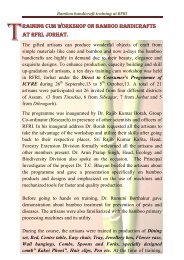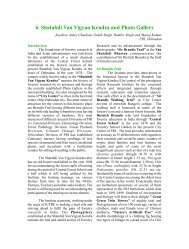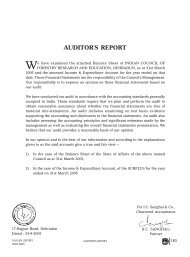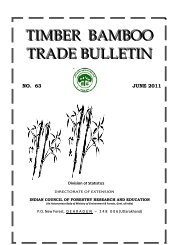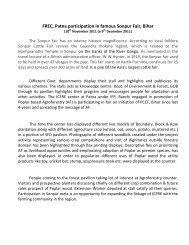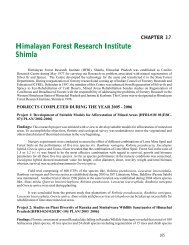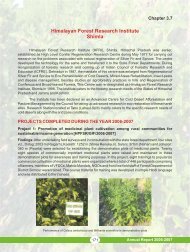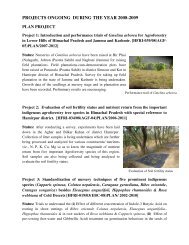PROJECTS CONTINUED DURING THE YEAR 2006-2007 ... - ICFRE
PROJECTS CONTINUED DURING THE YEAR 2006-2007 ... - ICFRE
PROJECTS CONTINUED DURING THE YEAR 2006-2007 ... - ICFRE
Create successful ePaper yourself
Turn your PDF publications into a flip-book with our unique Google optimized e-Paper software.
<strong>PROJECTS</strong> <strong>CONTINUED</strong> <strong>DURING</strong> <strong>THE</strong> <strong>YEAR</strong> <strong>2006</strong>-<strong>2007</strong> back<br />
Project 1: Introduction and performance trial of Paulownia species for<br />
agroforestry in different agro-climatic zones of Himachal Pradesh [HFRI-<br />
026/08 (AGF-02) PLAN/2003- 2008]<br />
Status: To mitigate the increasing demands of timber, fuel and fodder, systematic<br />
introduction trials of Paulownia species viz. P. fortunei, P. fargessi, P. elongate and P.<br />
tomentosa in different agro-climatic zones of Himachal Pradesh were established.<br />
Trial on inter-cropping of Paulownia spp. with tea is also maintained.<br />
Project 2: Diagnostic survey and appraisal of existing agroforestry systems<br />
in mid and high hills of Himachal Pradesh [HFRI-028/08 (AGF-03) PLAN/<br />
2003-2008]<br />
Status: After extensive diagnostic surveys, the existing agro-forestry systems in mid<br />
and high hill temperate regions of Kullu district of Himachal Pradesh were identified.<br />
Based on the size of operational land holdings, farmers were divided into four<br />
categories viz. marginal, small, medium and large. Socio-economic studies in<br />
different categories of farmers were carried out for structure of the family, education<br />
status of the head of family, land use statistics, status of the government<br />
employment and livestock status. Survey was conducted using Semi Structured<br />
Interviews (SSI) with the farmers and data on biological yield and economic return of<br />
different existing agroforestry systems are being collected.<br />
Project 3: Standardization of nursery techniques of five dominant<br />
indigenous species (Capparis spinosa, Colutea nepalensis, Caragana<br />
gerardiana, Ribes orientale, Cratagus songarica) besides Eleaegnus<br />
angustifoli, Hippophae rhamnoides and Rosa webbiana of cold deserts<br />
[HFRI-019/03(EBC-08) PLAN/ 2002-2009]<br />
Status: Trials to understand the (i) Effect of different concentrations of Indole-3
Butyric Acid on rooting in shoot cuttings of Ribes orientale, Colutea nepalensis,<br />
Eleaegnus angustifolia, Hippophae rhamnoides and in root suckers of Rosa webbiana<br />
and Capparis spinosa, (ii) Effect of pre-sowing (hotwater and Gibbrellic Acid)<br />
treatment on germination behaviour in the seeds of Ribes orientale, Colutea<br />
nepalensis, Hippophae rhamnoides, Capparis spinosa and Rosa webbiana and (iii)<br />
Effect of medium (various ratios of sand and soil) on germination behaviour in the<br />
seeds of Ribes orientale, Colutea nepalensis, Hippophae rhamnoides, Capparis<br />
spinosa and Rosa webbiana were repeated, both in poly house and in nursery<br />
conditions. Besides this, experiments on the effect of mulching treatments on Ribes<br />
orientale, Hippophae rhamnoides, Rosa webbiana and Capparis spinosa were<br />
undertaken.<br />
Detailed ecological studies for the identified species were carried out in the already<br />
selected sites at Mane, Ladang, Kurith, Hurling, Tabo and at Samdoh falling in Spiti<br />
Valley of Himachal Pradesh. Data on various nursery trials revealed that hot water<br />
treatment for 24 hours in case of seeds of Hippophae rhamnoides gave maximum<br />
germination per cent.<br />
It was seen that the experiments as laid out inside the poly tunnels are performing<br />
well over the plants than those growing in the open nursery. Field trials to assess the<br />
performance of Eleaegnus angustifolia, Hippophae rhamnoides, Rosa webbiana and<br />
Colutea nepalensis were established.<br />
Nursery trials to assess the performance of seed germination in Rosa webbiana,<br />
Capparis spinosa, Caragana gerardiana and Ribes orientale were laid in under ground<br />
polyhouse, shade house and poly tunnels conditions. Besides this, effect of different<br />
concentration of IBA on rooting in Eleagnus angustifolia, Ribes orientale and<br />
Crategus songarica were also laid out in poly tunnels. Also, an experiment to assess<br />
the effect of different diameter classes of roots on rooting and growth in Rosa<br />
webbiana was initiated during the period.<br />
Project 4: Studies on plant diversity in cold deserts of district Kinnaur,<br />
Himachal Pradesh [HFRI-029/02(EBC-11)PLAN/2004-<strong>2007</strong>]<br />
Status: Carried out phytosociological studies at an altitude, varying from 3000-5000<br />
m above msl, in Labrang valley of Pooh sub-division of Kinnaur district of Himachal<br />
Pradesh.<br />
Analysed the vegetation data collected from Labrang valley (3000-5000 m) of Pooh<br />
subdivision of Kinnaur district. Out of 75 medicinal plant species recorded from the<br />
area, 16 species i.e. Aconitum heterophyllum, Bergenia stracheyi, Betula utilis,<br />
Corydalis govaniana, Dactylorhiza hatagirea, Heracleum candicans, Hyoscyamus<br />
niger, Hyssopus officinalis, Juniperus communis, Juniperus macropoda, Lactuca<br />
macrorhiza, Pleurospermum brunonis, Rheum webbianum, Rhodiola heterodonta,<br />
Selinum tenuifolium and Thymus linearis fall under the category of threatened<br />
plants.<br />
Project 5: Natural enemy complex of key and potential pests of five Quercus<br />
spp. of Himachal Pradesh [HFRI-027/06 (FPT-05) PLAN/2003-2008]<br />
Status: Studies on the Life cycle of 'Indian Gypsy Moth' (IGM) was repeated and<br />
detailed morphometric study was conducted on the immature stages of the moth.<br />
Nuclear Polyhedrosis Virus (NPV) was extracted from the infected larvae of the IGM,
purified and studied under TEM. Pupal parasitoid Exorista rosica<br />
was reported and as many as 21 species of predatory spiders<br />
were found among natural enemies.<br />
The immature larvae of IGM collected from the oak forest were reared on natural diet<br />
(oak leaf) in the laboratory and adults thus emerged were allowed to mate in a<br />
mating chamber to study the life cycle.<br />
NPV Study: The caterpillars reared in the laboratory were innoculated with viral<br />
suspension already purified from last year's infected larvae. The oak leaves were<br />
contaminated with viral suspension and the caterpillars were allowed to consume the<br />
leaves. Structural details of the virus were studied under Transmission Electron<br />
Microscope (TEM).<br />
Parasitoids and Predators: Exorista rosica, a pupal parasitoid of the family<br />
Tachinidae was found to be the most effective in controlling the population of IGM.<br />
Project 6: Survey, biology and control of insect-pests of important medicinal<br />
plants in Himachal Pradesh and Jammu and Kashmir [HFRI-033/06(FPT-<br />
07)PLAN/2005-2010]<br />
Status: In total 32 insect species were recorded from 13 selected medicinal plants,<br />
being cultivated in this region. The status of these insects on the basis of damage<br />
caused and their abundance has been assessed and found that Plusia orichalcea<br />
Fab., is the most destructive pest. The biology of P. orichalcea on Saussurea costus<br />
was completed in the laboratory.<br />
Different development stages of P. orichalcea and their morphological characteristic<br />
have also been studied in the laboratory. First time, mite infestation was recorded on<br />
Valeriana jatamansi Jones; in Himachal Pradesh and the infestation ranged from 30-<br />
80 per cent in nursery. The species of mites were identified as Panonychus ulmi<br />
(Koch), European Red Mites and Tetranychus urticae (Koch), Spider Mite and they<br />
are otherwise supposed to be the destructive pests of Apple.<br />
Project 7: Diagnostic study of indigenous and institutionalized participatory<br />
forest management in Himachal Pradesh [HFRI-025/08 (PFM-01) PLAN/<br />
2005- 2008]<br />
Status: Survey of various village forest development committees and panchyats<br />
were carried out in Nahan, Rampur, Mandi and Dharmashala circles. Staff interviews<br />
were also carried out.<br />
Project 8: Planting stock improvement programme in Cedrus deodara<br />
[HFRI-028/05(SFG-08) PLAN-03/2003-2008]<br />
Status: Based on the survey carried out to select best seed stands of deodar in the<br />
states of Himachal Pradesh and Jammu and Kashmir, selection of the seed stands<br />
was done on the basis of sample plot studies. These sample plot studies were carried<br />
out to supplement ocular selection of seed stands for their conversion into Seed<br />
Production Areas (SPAs). The two seed stands i.e., Cheog Forest (20 ha) of Theog<br />
Forest Division and Nankhari Forest (15 ha) of Rampur Forest Division were finally<br />
selected for complete enumeration.
The seed stand identified in Neeru range of Bhadrawah Forest Division in the state of<br />
Jammu and Kashmir in collaboration with State Forest Research Institute, Jammu<br />
were prepared and are in the process of submission to the authorities concerned.<br />
Cones were also collected from 52 Plus Trees identified in different forest areas and<br />
progeny trial raised in the nursery.<br />
Project 9: Allozyme variation in natural populations of deodar (Cedrus<br />
deodara) [HFRI- 030/05(SFG-10) PLAN-03/2005-2008]<br />
Status: The genetic diversity and differentiation using isozyme techniques in<br />
different populations (15) of deodar are being studied by assaying five enzyme<br />
systems namely SKDH, MNR, IDH, GDH and MDH. Seven populations, six from the<br />
state of Himachal Pradesh and one from Jammu and Kashmir were electrophoresed<br />
for these enzyme systems.<br />
Shikimic Acid Dehydrogenase (SKDH): One zone of activity with three single<br />
banded phenotypes was identified both for endosperm and embryos.<br />
Malate Dehydrogenase (MDH): Gels stained for MDH showed four zones of<br />
activity. The system has been studied for three populations and would be studied for<br />
remaining populations this year.<br />
During the year efforts were also made to score more enzyme systems and in this<br />
endeavour standardized the staining protocols for two more systems i.e., MDH and<br />
6PGDH. These enzyme systems are now being assayed for the populations being<br />
studied for genetic diversity and differentiation in the species.




